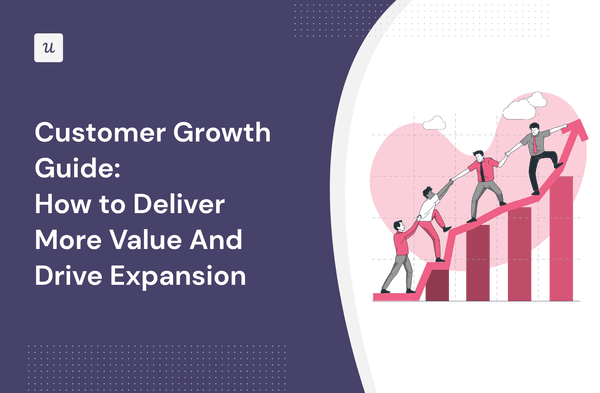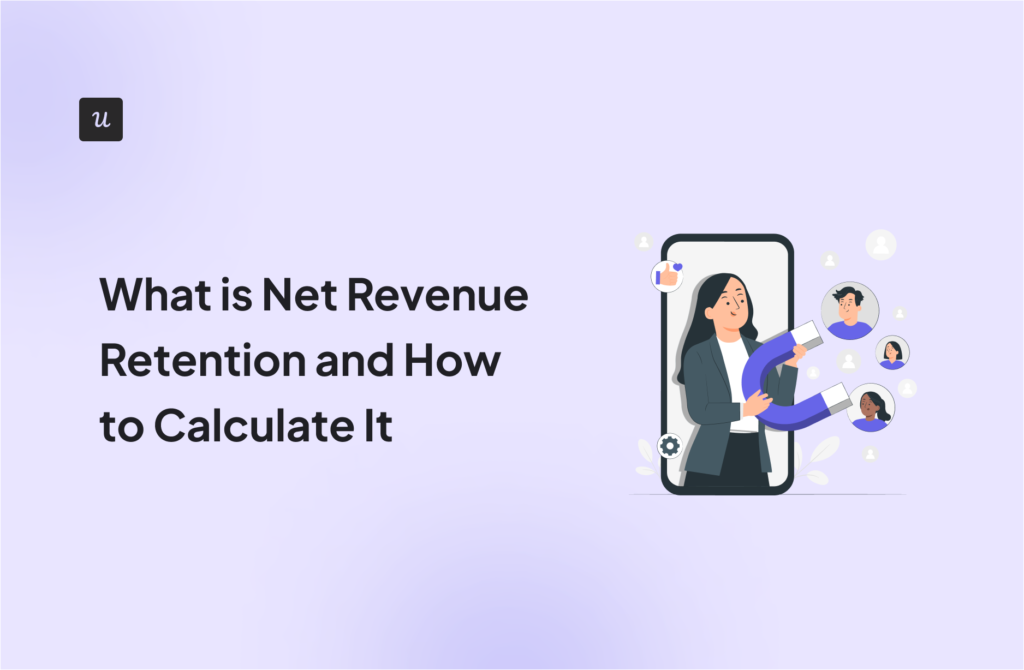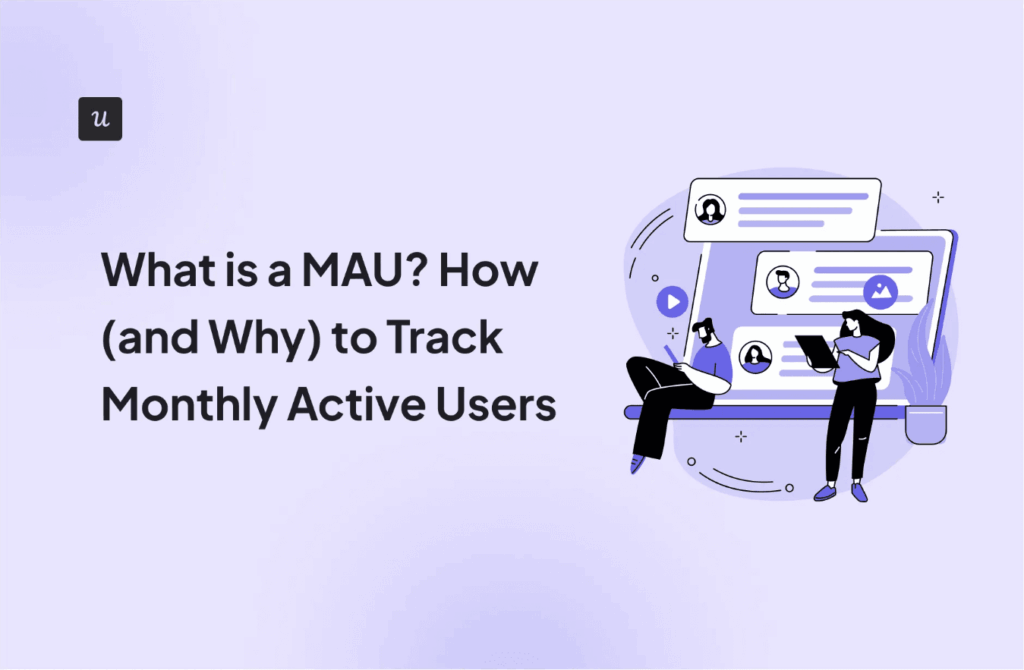
Looking for ways to measure and increase customer growth?
Your search ends here. Here is what this customer growth guide covers:
- Customer growth explained: what is it?
- The top metrics to measure customer growth rate.
- Proven strategies for attracting users, retaining them, and driving account expansion.
- How Userpilot helps companies like yours to drive growth.
Try Userpilot Now
See Why 1,000+ Teams Choose Userpilot

Summary of customer growth guide
- Customer growth is the expansion of a company’s customer base over time. The primary benefit is increased revenue.
- Top metrics to measure customer growth are:
- Customer retention
- Revenue growth
- Customer lifetime value
- Monthly recurring revenue
- Churn rate
- Customer satisfaction score
- Net Promoter Score
- The formula to calculate customer growth rate is = (number of customers in the current period – number of customers in the previous period )/customers in the previous period X 100.
- Five customer growth strategies to implement:
- Help users discover features relevant to them.
- Drive engagement and product adoption with product guides.
- Increase upsells with contextual upgrade in-app messages.
- Identify detractors and proactively reduce churn.
- Increase new customer acquisition by incentivizing existing customers to refer others.
- Userpilot can help measure customer growth and boost retention by tracking user behavior and creating proactive solutions to remove friction, reduce churn, and prompt feature discovery. Hop on a quick demo call to learn more.
What is customer growth?
Customer growth is the expansion of a company’s customer base over time. It’s a fundamental aspect of business development and often a primary goal for companies, especially in the early stages of their existence.
Growth can manifest and be tracked in several ways, but more on that shortly. Let’s first look at the benefits.
The benefits of driving customer growth
The primary benefit of customer growth is the increase in revenue. This happens because growth means two things—new user acquisition and customer retention to ensure existing users keep expanding their engagement and get motivated to stick around.
Growth-focused companies pay less attention to acquisition and more to retention because they understand retention has ripple effects—satisfied and loyal customers become your brand advocates, bringing new users through word of mouth.
There’s data to prove the importance of retention over acquisition. A 25% increase in retention drives a 31% increase in MRR, while increasing acquisition by the same percentage only yields a 25% increase in MRR.

Top metrics to measure customer growth
To assess customer growth effectively, it’s important to consider a variety of key metrics, as no single KPI can tell the whole story. Below are seven essential metrics to track.
Customer retention
Customer retention is your company’s ability to keep existing users over a specific period. Monitoring retention provides insights into customer loyalty and helps you identify areas for improvement in customer satisfaction and product quality.
You can calculate this by subtracting the number of users acquired during a specific period from the number of paying users at the end of the specific period. Then, divide the result by the number of customers at the start of the period and multiply by 100.

Here’s an example:
Suppose you have 500 paying customers at the beginning of a month, and by the end of the month, you still have 450 of those customers. Additionally, during that month, you acquired 50 new customers.
Your customer retention rate = [(450 – 50) / 500] x 100 = 80%
A closely related metric you should also consider tracking and reducing is the customer retention cost—the expense of keeping an existing customer.
Revenue growth
This metric measures the increase in your company’s total revenue over a specified time frame.
It’s a key indicator of your company’s overall performance and growth. You can track this metric monthly (MOM growth) or yearly (YOY growth). Whichever duration you choose, just ensure to do it regularly so you can spot any changes easily.
To calculate revenue growth, subtract the revenue generated in the previous period from the revenue generated in the current period and divide the result by the revenue generated in the previous period. Then, multiply by 100.

For example, if your company’s revenue was $10 million in 2022 and $12 million in 2023, then its revenue growth would be:
[(12,000,000 – 10,000,000)/10,000,000] X 100 = 20%
Customer lifetime value
Customer lifetime value (CLV) is an estimate of the total revenue you can expect to generate from a customer throughout their relationship with you.
To calculate CLV, multiply the customer value by the average customer lifespan for your product.
The result won’t give you a 100% accurate answer because the fact that your customers spend an average of two years with you doesn’t mean another customer won’t spend way more or less time using your tool.
However, the formula provides a good estimate and can guide decisions like how much to invest in driving customer growth.

Monthly recurring revenue
MRR is the total amount your company expects to generate monthly from active, paying customers. This is a vital metric for tracking growth because by comparing the results over time, you can tell whether your company is progressing.
It’s easy to calculate MRR. Simply multiply the average revenue per account or user (ARPU) by the total number of accounts in a month.

Churn rate
The customer churn rate is the opposite of the customer retention rate. It measures the percentage of customers who stop using your product or service within a specific time frame.
Calculate your customer churn rate by dividing the total number of users lost during a specific period by the total number of users at the beginning of the period. Multiply the result by 100.

Example: If you started November with 1,000 users, and by the end of the month, 100 users have discontinued their subscription or stopped using the product, your churn rate is:
= (100 / 1,000) x 100 = (0.1) x 100= 10%
Customer satisfaction score
The customer satisfaction score, or CSAT for short, is a ratio that measures how satisfied customers are with your products and services.
You can trigger CSAT surveys at different points in the customer journey to track their satisfaction and see if it’s growing. High user satisfaction is directly tied to retention and loyalty. In other words, growth happens when customers are happy.
To measure this critical metric, first conduct CSAT surveys, then find the ratio between happy customers and the total number of customers asked.
Save your scores because you’ll need to return to them regularly and see the trend in user satisfaction over time.

Net Promoter Score
Net Promoter Score (NPS) is a widely used metric to assess customer loyalty and gauge the willingness of customers to recommend your product, service, or company to others.
NPS is based on a single, straightforward question: “On a scale of 0 to 10, how likely are you to recommend our product/service to a friend or colleague?” You can play around with your wording, but the essence of the question and the 0-10 scale remains unchanged.
Users are categorized into three groups based on their responses:
- Promoters (score 9-10): highly satisfied customers who are likely to recommend your product.
- Passives (score 7-8): mostly satisfied users who aren’t enthusiastic enough to actively promote your product.
- Detractors (score 0-6): unsatisfied customers who may have negative feelings about your product.
Once you have the above data, calculate NPS by subtracting the percentage of detractors from the percentage of promoters:

How to calculate customer growth rate?
The customer growth rate is a key performance indicator (KPI) that measures your speed in acquiring new customers over a specific period.
The customer growth rate is calculated by subtracting the number of customers in the previous period from the number of customers in the current period and dividing the result by the number of customers in the previous period. Multiply the result with 100 to get the rate.

A positive trend in customer growth indicates that your business is successfully acquiring more customers than it’s losing, which is a sign of healthy growth.
On the other hand, a negative growth rate indicates a decline in the customer base and a need to dig further and address issues ASAP. It could be that you’re acquiring the wrong users or customers aren’t satisfied with your tool.
Conduct feedback surveys at different points in the customer journey, and A/B test your acquisition and in-app growth strategies to see what can be improved.
Best strategies to include in your customer growth strategy
Not satisfied with your current growth or just convinced there’s room for improvement?
Below are some proven growth strategies to implement.
Help users discover features relevant to them
Growth declines when users struggle to make sense of your tool or can’t see how your product solves their problems.
Avoid this situation by triggering personalized feature discovery. Analyze product usage and note features that have low engagement. If users aren’t engaging with important features, trigger flows that help them discover aspects of your tool that they’re missing.

Drive engagement and product adoption with product guides
It’s not enough to trigger feature discovery. Hold users by the hand and show them how to get the most value from your features. Doing this will lower the learning curve for your tool and result in repeated engagement.
To guide users, trigger a product walkthrough that shows them step-by-step how your product works. The good thing about walkthroughs is that they encourage users to actively participate in the learning process. By the time the walkthrough is over, users will get the hang of your features and be ready to start engaging.

Increase upsells with contextual upgrade in-app messages
Trigger your upgrade prompt based on user behavior and usage patterns. For example, if a user frequently uses a specific feature, provide an in-app message promoting an upgrade to a premium plan with enhanced access to that feature.
Loom did something similar. After rolling out a new feature, they sent an in-app message to users, offering a free trial so users can test the feature and upgrade.

Identify detractors and proactively reduce churn
Remember what we said about detractors? (Hint: they are users who are dissatisfied with your product or service and on the verge of churn).
After conducting NPS surveys and finding detractors, segment them and use funnel analysis to understand where they face friction. Then, create solutions to help them enjoy your product better.

It also helps to survey detractors and learn directly from them. Ask the reasons for their dissatisfaction. Take note of recurring complaints, then find ways to address them. Once you’ve created a solution, don’t forget to get back to these users about the changes you’ve made. This will make them feel valued and encourage long-term retention.
Increase new customer acquisition with referral programs
People are generally skeptical about marketing materials that come directly from a company. However, their guards are down when it’s a friend, boss, or colleague telling them how good a product is.
So, how do you encourage your loyal users to spread the word about you?
A good approach is to create a referral program with rewards your users will find valuable. This can be anything from discounts on their subsequent renewals to free credits or access to premium features.
For Dropbox, what moved the needle was rewarding both the advocate and the new customer with extra storage space.
Seeing they could get extra space as a reward, users were motivated to tell people on social media about Dropbox. New customers were happy to have the 500 MB storage reward upon signup, so this campaign became a viral loop that helped Dropbox expand quickly.

How can Userpilot help you drive customer growth?
Userpilot is a product growth platform that helps SaaS companies boost adoption, engagement, and retention.
- Track feature adoption and usage levels with feature tagging. Determine which features are relevant for different user groups based on how they engage. Armed with this data, you can decide on who to enable your feature discovery flows for and how to better boost engagement.
- Track user activity and engagement with in-depth product analytics (trends, funnels, paths, and cohort analysis). All these Userpilot features help you get real-time data on in-app user behavior and make data-driven decisions. For example, cohort analysis helps you understand which features drive stickiness and lead to growth. You can then make these features the first thing new users see in your onboarding flow.

- Use the data you collect to drive engagement. From in-app checklists to interactive product walkthroughs, Userpilot arms you to drive in-app engagement through contextual guides. Here’s an example of combining UI elements to create a user onboarding flow that educates new customers and drives adoption.

If you want to collect feedback directly from users, our platform also has in-app survey templates you can use. Think NPS, CSAT, and CES.
Conclusion
Customer growth happens as long as users keep deriving value from your tool.
Ensure the customer success team (or whoever is responsible in your company) regularly tracks customer growth metrics and takes immediate action when there’s a decline. For instance, if your MRR two months ago was higher than what you had last month, dig further to find out why. By taking this curious approach, it becomes easier to spot and address issues before they blow up.
Ready to start driving customer growth? Get a Userpilot Demo and see how you can track user behavior and trigger flows to boost engagement and retention.







